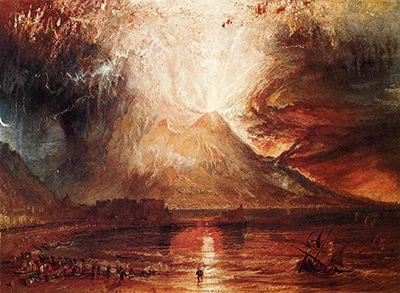Mount Vesuvius erupted in AD 79, causing one of the most notorious disasters of its time.
The shock of the eruption that buried a city ripples into today; it is one of the most well-known volcanic eruptions known to the general public, and even finds its way into TV shows and movies.
Its drama and lingering effects make it easy to see why J. M. W. Turner would have been captured by the mountain.
In 1817, Turner did exactly that. At this time, a fascination with volcanoes had entered the mainstream, especially Vesuvius which had begun to erupt in what is now Italy multiple times.
Due to this notoriety, all eyes were on the volcano as it became active once more. The resultant painting is striking and unusual, glowing red from the page, full of dark contrasts and drama.
The painting itself carries that drama well. The onlookers on the shore seem to recoil from the sight while being drawn to it, just as the viewer is when looking at the painting.
Waves hit the shore and the volcano itself is beyond, tall and majestic, throwing lava and ash into the darkened sky. Billows of acrid smoke flow out of the sides of Vesuvius, clouding up the sky. Once the eye touches this painting, it is difficult to look away.
Once of Turner's greatest talents was the ability to show light on the canvas in a convincing, realistic way. This talent shows through in 'Eruption of Vesuvius', in which the light from the heat of the eruption seems to resonate from the canvas, flooding the scene with an almost unbearable heat.
It is possible to imagine, thanks to Turner, how it felt to be standing on that shore watching the Earth turn to its most violent self. Looking at the apex of the mountain, the violence of the eruption is obvious, and the clouds of ash and debris seem almost peaceful in comparison.
It is a strange contradiction that our planet can be at its most beautiful when it is also its most lethal, and Turner takes this reality to turn it into one of his earlier but more eye-catching creations.




